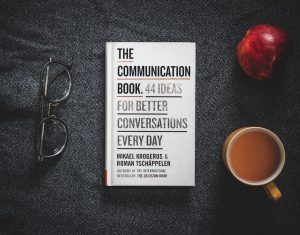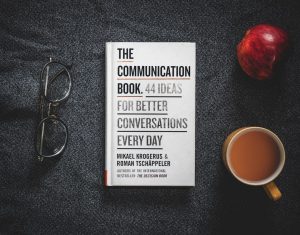Master Effective Communication: 10 Essential Tips
Unlock the secrets to effective communication with our top 10 tips. Enhance your skills and connect better today. Explore more now!
Importance of Effective Communication in Business
1. Clarity and Precision
Effective communication ensures that messages are conveyed with clarity and precision.
This reduces misunderstandings and errors, allowing for smoother operations. By being clear and precise, businesses can ensure that all team members are on the same page, which is crucial for achieving organizational goals.
2.
Building Strong Relationships
Strong communication skills help in building and nurturing relationships with clients, partners, and employees. When communication is open and transparent, it fosters trust and loyalty, which are essential for long-term business success.
3.
Increased Productivity
When communication is effective, it streamlines processes and reduces the time spent on clarifying tasks and responsibilities. This leads to increased productivity as employees can focus on their core tasks without unnecessary interruptions.
4.
Conflict Resolution
Conflicts are inevitable in any business environment. Effective communication provides the tools to address and resolve conflicts efficiently.
By listening actively and expressing thoughts clearly, businesses can mitigate conflicts before they escalate.
5. Enhanced Decision-Making
Good communication practices ensure that all relevant information is shared and understood, leading to better decision-making.
When team members are well-informed, they can contribute valuable insights, allowing for more informed and effective business decisions.
6. Boosting Employee Engagement
Employees who feel heard and understood are more likely to be engaged and motivated.
Effective communication fosters a positive work environment where employees feel valued, leading to higher job satisfaction and retention rates.
7. Facilitating Innovation
Open communication encourages the sharing of ideas and feedback, which is essential for innovation.
Businesses that promote a culture of open dialogue are better positioned to adapt to changes and implement innovative solutions.
8. Strengthening Brand Image
Consistent and effective communication with external stakeholders helps in building a strong brand image.
Clear messaging and responsiveness to customer inquiries enhance a company’s reputation and credibility in the market.
9. Effective Leadership
Leaders who communicate effectively can inspire and guide their teams towards achieving business objectives.
Effective communication is a key component of leadership, enabling leaders to articulate vision and strategy clearly.
10. Adapting to Change
In a rapidly changing business environment, effective communication is crucial for managing change.
By keeping everyone informed and involved, businesses can navigate transitions smoothly and maintain operational continuity.
Active Listening Techniques for Improved Communication
Maintain Eye Contact
Maintaining eye contact is a fundamental aspect of active listening. It shows the speaker that you are engaged and interested in what they are saying.
This non-verbal cue helps build trust and encourages open communication. However, be mindful of cultural differences regarding eye contact to ensure comfort for both parties.
Provide Feedback
Feedback is crucial in active listening as it demonstrates comprehension and engagement.
Use verbal affirmations like “I see,” “I understand,” or “That makes sense” to signal that you are following along. Additionally, paraphrasing or summarizing what the speaker has said can confirm your understanding and clarify any potential misunderstandings.
Ask Open-Ended Questions
Open-ended questions encourage the speaker to elaborate and provide more detailed information.
This technique not only shows that you are attentive but also fosters a deeper understanding of the topic. Questions like “Can you tell me more about that?” or “How did that make you feel?” invite the speaker to share more of their perspective.
Avoid Interrupting
Interrupting can disrupt the flow of conversation and make the speaker feel undervalued.
Practice patience by allowing the speaker to finish their thoughts before responding. This demonstrates respect and allows you to fully process the information being shared, leading to more thoughtful and relevant responses.
Observe Non-Verbal Cues
Non-verbal cues, such as body language, facial expressions, and tone of voice, provide valuable context to the speaker’s message.
By paying attention to these cues, you can gain a deeper understanding of the speaker’s emotions and intentions, which can enhance the overall communication experience.
Practice Empathy
Empathy involves putting yourself in the speaker’s shoes and understanding their perspective. This technique helps create a supportive environment where the speaker feels heard and validated.
By acknowledging their feelings and experiences, you can build stronger connections and facilitate more meaningful conversations.
Nonverbal Communication Tips for Business Success
Maintain Eye Contact
Eye contact is a powerful tool in nonverbal communication. It conveys confidence, attentiveness, and respect.
In business settings, maintaining appropriate eye contact can help build trust and rapport with colleagues and clients. However, it’s important to strike a balance; too much eye contact can be perceived as aggressive, while too little may suggest disinterest or evasiveness.
Mind Your Posture
Your posture can speak volumes about your attitude and level of engagement.
Standing or sitting up straight with shoulders back projects confidence and openness. Avoid crossing your arms, as this can be interpreted as defensive or closed off.
In meetings, lean slightly forward to show interest and engagement in the conversation.
Use Gestures Wisely
Gestures can enhance your verbal communication when used appropriately. They help emphasize key points and make your message more memorable.
However, excessive or erratic gestures can be distracting. Aim for natural, purposeful movements that complement your words.
Be mindful of cultural differences in gesture interpretation, especially in international business settings.
Pay Attention to Facial Expressions
Your facial expressions can significantly impact how your message is received. A genuine smile can create a positive atmosphere and encourage collaboration.
Be aware of your expressions during conversations, as they can unintentionally convey emotions such as frustration or disapproval. Practice maintaining a neutral or positive expression to foster a more welcoming and professional environment.
Respect Personal Space
Understanding and respecting personal space is crucial in business interactions.
Standing too close can make others feel uncomfortable, while standing too far away might seem disengaged. Pay attention to cues from others and adjust your distance accordingly.
In virtual meetings, be mindful of your on-screen presence, ensuring your face is clearly visible without being too close to the camera.
Overcoming Barriers to Effective Workplace Communication
Understand Cultural Differences
In a diverse workplace, cultural differences can pose significant communication challenges. It’s essential to recognize and respect these differences to foster an inclusive environment.
Encourage employees to share their cultural backgrounds and traditions, which can help build understanding and reduce misinterpretations.
Encourage Open Dialogue
Creating a culture of openness where employees feel comfortable expressing their thoughts and concerns is crucial. Encourage team members to speak up during meetings and provide feedback.
This can be achieved by actively listening and validating their contributions, which can help break down communication barriers.
Utilize Clear and Concise Language
Using clear and concise language helps prevent misunderstandings. Avoid jargon and overly complex terms that may confuse team members.
Instead, focus on delivering messages in a straightforward manner, ensuring that everyone understands the key points.
Implement Active Listening Techniques
Active listening involves fully concentrating, understanding, and responding to what is being said. Encourage employees to practice active listening by making eye contact, nodding, and asking clarifying questions.
This approach not only improves communication but also builds trust among team members.
Leverage Technology Wisely
Technology can both aid and hinder communication. Utilize tools like video conferencing and instant messaging to facilitate communication, especially in remote or hybrid work settings.
However, be mindful of over-reliance on digital communication, which can lead to misinterpretations. Balance digital and face-to-face interactions to maintain effective communication.
Provide Regular Training
Regular communication training can help employees develop essential skills.
Workshops and seminars on topics like effective listening, non-verbal communication, and conflict resolution can empower employees to communicate more effectively and confidently.
Address Language Barriers
In multilingual workplaces, language barriers can impede communication. Providing language support services, such as translation tools or language classes, can help bridge these gaps.
Encourage patience and empathy among team members to support colleagues who may struggle with language proficiency.
Set Clear Expectations
Clearly defined roles and responsibilities can prevent confusion and ensure everyone is on the same page. Set clear expectations for communication protocols, including response times and preferred communication channels, to streamline interactions and reduce potential misunderstandings.
Foster a Positive Work Environment
A positive work environment encourages open and honest communication.
Recognize and reward effective communicators, and address any negative behaviors that may hinder communication. A supportive atmosphere can significantly enhance overall communication within the workplace.
Encourage Feedback and Continuous Improvement
Feedback is a valuable tool for improving communication.
Encourage employees to provide constructive feedback on communication practices and be open to making necessary adjustments. Continuous improvement in communication strategies can lead to a more cohesive and productive workplace.
FAQ
Q1: How can I effectively apply communication tips in a fast-paced business environment?
A1: Applying communication tips in a fast-paced business environment requires prioritizing clarity and conciseness. Start by actively listening to understand the core message before responding. Use clear and direct language to convey your points, and tailor your communication style to suit your audience. For instance, when communicating with executives, focus on high-level insights and outcomes, whereas, with team members, you might delve into more detailed instructions. Additionally, leverage digital tools like email and instant messaging for quick updates but reserve face-to-face or video meetings for more complex discussions.
Q2: How can I assess whether my communication skills are improving in a business setting?
A2: To assess your communication skills, seek feedback from colleagues and supervisors regularly. Pay attention to both verbal and non-verbal cues during interactions—are people engaging more with your ideas, or do they seem confused? You can also track your progress by setting specific communication goals, such as increasing the clarity of your emails or improving your public speaking skills. Self-reflection after meetings or presentations can help identify areas for improvement. Additionally, consider using tools like surveys or performance reviews to gather structured feedback on your communication effectiveness.
Q3: Are there any recommended books for further improving communication skills in business?
A3: Yes, several books can help enhance your communication skills in a business context. “Crucial Conversations: Tools for Talking When Stakes Are High” by Kerry Patterson, Joseph Grenny, Ron McMillan, and Al Switzler is highly recommended for learning how to handle difficult conversations effectively. “The Art of Communicating” by Thich Nhat Hanh offers insights into mindful communication, which can be beneficial in maintaining calm and focus in high-pressure situations. Additionally, “Never Split the Difference: Negotiating As If Your Life Depended On It” by Chris Voss provides valuable strategies for negotiating and communicating persuasively.
Takeaway
Ready to level up your skills and boost your career success? Take the first step today by enrolling in our online course, downloading our top-rated productivity tool, or subscribing to receive weekly career tips. Start your journey towards achieving your goals now!
References











Comments